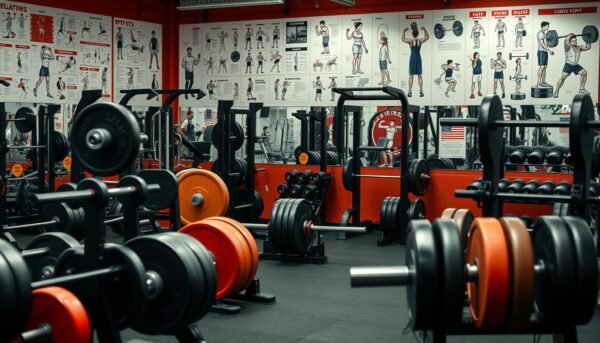Are you ready to unlock your true strength potential? Whether you’re a seasoned runner or a fitness enthusiast, becoming a weight lifter is rewarding. I’ll share my experiences and insights to guide you.
You’ll learn the essential techniques and strategies for success. From mastering the basics to optimizing your training and nutrition, we’ll cover it all. Are you ready to start a transformative journey that challenges your body and empowers your mind? Let’s explore the world of weight lifting together!
The Beginner’s Mindset: Embracing the Journey
As a beginner weight lifter, it’s key to see mistakes as part of your growth. Even top athletes face challenges when starting something new. Keep a positive outlook and aim to always get better, not to be perfect.
Mistakes help us grow and learn. If you never made mistakes, you wouldn’t learn as much. Be okay with being a beginner and trying new things. This is how you truly get better and become good at weight lifting.
The journey is as important as reaching your goal. Enjoy learning and finding out what you can do as a beginner weight lifter. Every mistake brings you closer to mastering the learning process and reaching your strength gains. This mindset helps you improve and stay safe from injuries.

The way to become a skilled weight lifter is full of obstacles. But facing them with a positive attitude will lead to more progress and strength gains. Don’t forget, mistakes are crucial for learning. Celebrate your wins, learn from your losses, and enjoy the ride as a beginner weight lifter.
Avoiding the “Grab Bag” Approach
As a weight lifter, avoiding the “grab bag” approach is key. This mix of different classes and exercises can harm us, especially runners. We must focus on the main principles of strength training for real gains.
Strength coach Randy Hauer says it’s vital to rest between sets. He warns against too much aerobic training, which hurts strength and power. Hauer suggests doing full-body exercises that challenge us, not just mimic running with weights.
Choosing a focused strength training plan helps us progress faster and avoid injuries. By avoiding the weight training mistakes of the “grab bag” method, we get the most from functional strength classes and CrossFit.
| Metric | Benefit of Proper Strength Training |
|---|---|
| Progress | Faster improvements with strength training exercises |
| Injury Risk | Mitigated risks when following proper techniques |
| Results | More substantial strength gains |
| Physical Abilities | Improved power, speed, coordination, lean muscle, and efficiency |

Embracing a focused strength training plan unlocks our full potential. It’s time to leave the “grab bag” behind and embrace proven methods for better fitness.
Lifting Weights Like a Runner, Not a Bodybuilder
As a runner, I lift weights differently than bodybuilders. Bodybuilders aim to grow muscle size. I focus on building strength and power for better running. I use compound exercises that work my whole body.
I don’t need to spend as much time in the gym as bodybuilders. Runners can get strong and fast with shorter, less frequent workouts. These workouts focus on compound movements and allow for recovery. This helps runners, not just build muscle.
Bodybuilding vs. Strength Training for Runners
Bodybuilders lift weights 5-7 days a week. They do high-volume, low-intensity exercises with 8-12 reps. Runners, like me, do high-intensity training with 1-6 reps, 3-4 days a week. We focus on full ranges of motion and exercises that work our whole body.
My training is for runners, not muscle growth. It helps me get stronger and faster without endless gym time. Training like an athlete, not a bodybuilder, is key.
| Bodybuilding | Strength Training for Runners |
|---|---|
| 5-7 days per week | 3-4 days per week |
| High volume, low intensity (8-12 reps) | High intensity, lower volume (1-6 reps) |
| Isolation exercises | Compound exercises |
| Focus on muscle hypertrophy | Focus on neuromuscular adaptations and running performance |
By lifting like a runner, I build the strength needed for trails and roads. It’s smarter, not harder, than bodybuilding.

Embracing Stability and Power Training
As a weight lifter, it’s key to know how stability and power training help. Stability exercises, like those on Swiss balls, are good for injuries. But they don’t help much with getting stronger or more powerful.
Being able to push out force fast is what boosts athletic performance. This is best done with big, multi-joint exercises. Too much stability training can mess with how your muscles work.
Instead, do power training like Olympic lifts and medicine ball throws. These exercises work your muscles hard. They also make your fast-twitch muscles stronger and improve how well you move.
Putting strength and power training together in your plan is smart. It helps you do better in weightlifting contests. A mix of stability, strength, and power is what makes a great weight lifter.
| Benefit | Impact |
|---|---|
| Grip Strength | Reliable indicator of Central Nervous System (CNS) readiness |
| Olympic Lifts | Promote fast-twitch muscle fiber activation, enhance proprioception and coordination, improve blood pressure regulation, and challenge the cardiovascular system |
| Strength Training | Increases force production, prevents injuries, and improves muscle coordination |
| Power Development | Enhances explosive strength and speed, leading to faster lift execution and improved athletic performance |
A mix of stability, strength, and power training is key. It helps you reach your full potential in weightlifting. By using these methods, you’ll meet your goals in the sport.

A Weight Lifter’s Strength Training Program
Building a strong strength training routine is key for weight lifters. Focus on big exercises like squats, deadlifts, and bench presses. Do these with heavy weights (60-80% of your max) for 1-8 reps per set.
To make a good weight lifting program, follow these tips:
- Do 3-6 sets for each exercise to build strength.
- Rest for 1-3 minutes between sets to recover fully.
- Try different exercises to work on various muscles and movements.
- Keep adding more weight or reps to keep pushing yourself.
This method is better for building strength and power. It’s more effective than doing lots of reps or focusing on one muscle at a time.

Training cycles can last 8 to 12 weeks. Intensity levels can be moderate to high. Some programs focus on legs, overheads, or pulling. Others are more balanced. The main thing is to stay consistent, track your progress, and adjust as needed.
Fueling Your Body as a Weight Lifter
As a weight lifter, eating right is key. It helps build strength, grow muscle, and recover well. You need to balance protein, carbs, and healthy fats at the right times.
I aim for 1.2 to 2 grams of protein per kilogram of my weight daily. This protein comes from lean meats, fish, dairy, and legumes. I also use high-quality protein supplements like whey or casein. I spread out my protein intake, eating 15-35 grams per meal and 10-15 grams per snack.
Carbs are important for my workouts and to refill glycogen. I aim for 5 to 12 grams of carbs per kilogram of body weight daily. I focus on whole grains, fruits, and veggies. Before and after workouts, I eat 30-45 grams of carbs and 15-20 grams of protein 60-90 minutes beforehand. After, I eat 25-50 grams of carbs and 15-25 grams of protein within 30 minutes.
This post may contain affiliate links which means I may receive a commission for purchases made through links. I will only recommend products that I have personally used! Learn more on my Private Policy page.